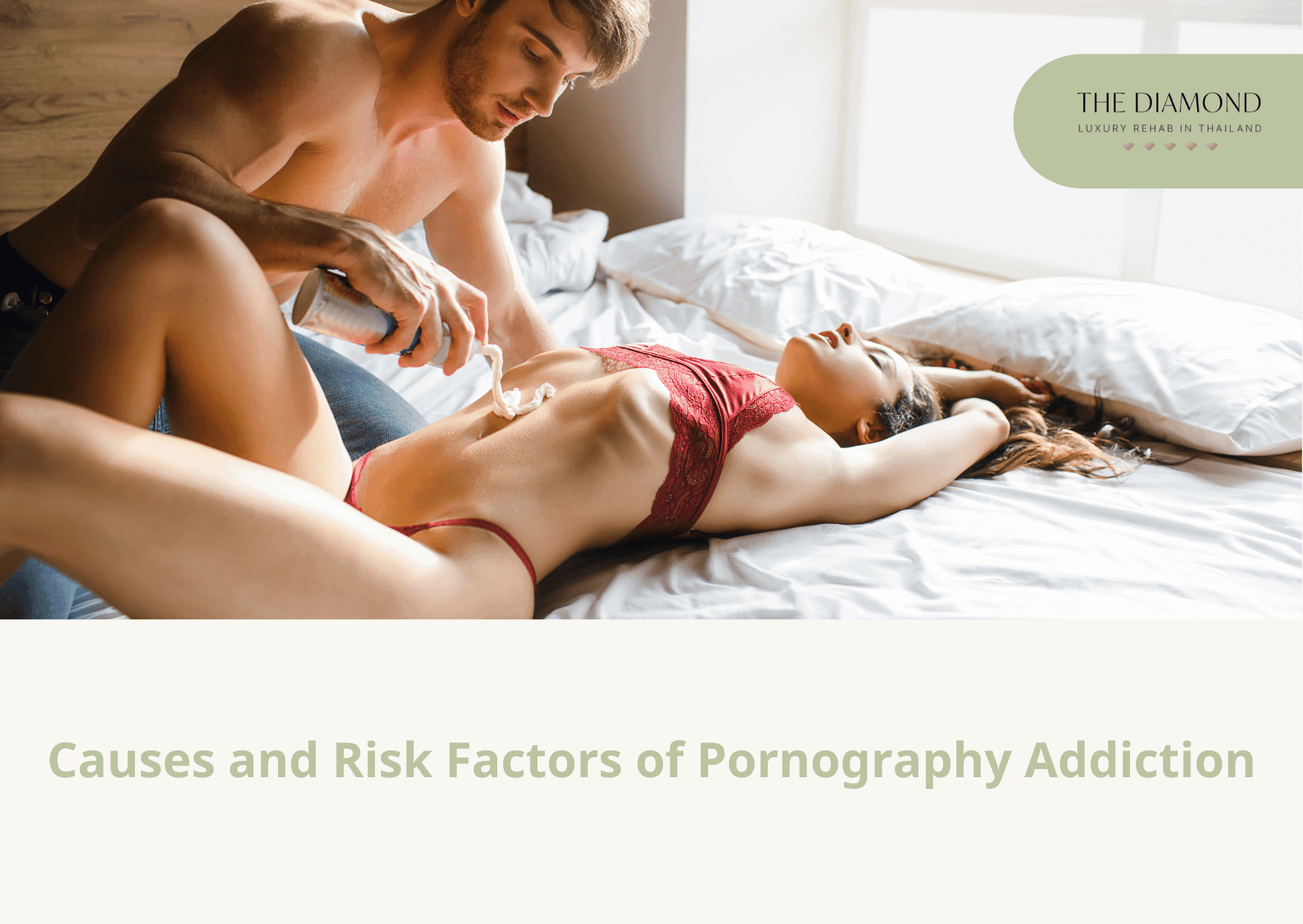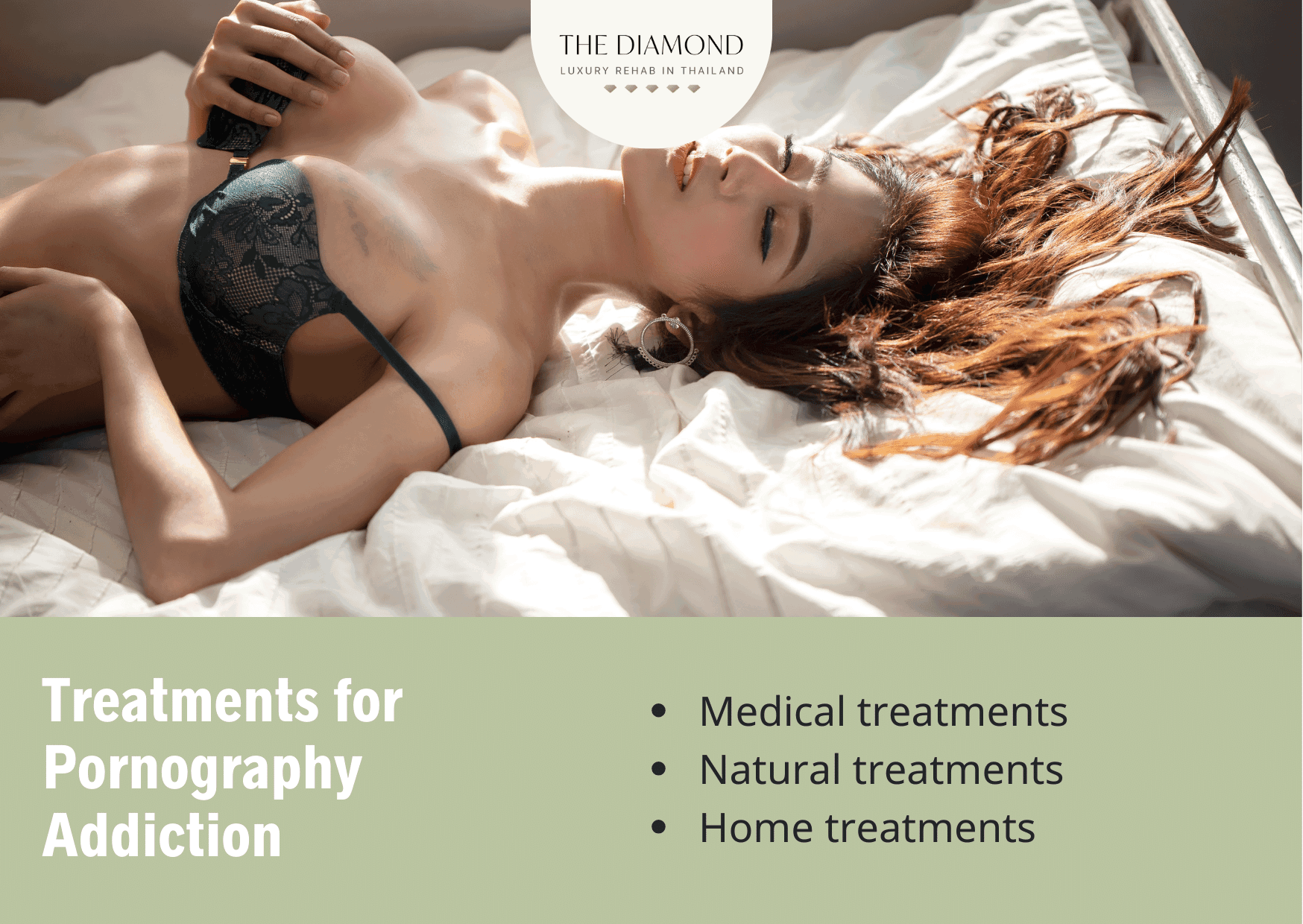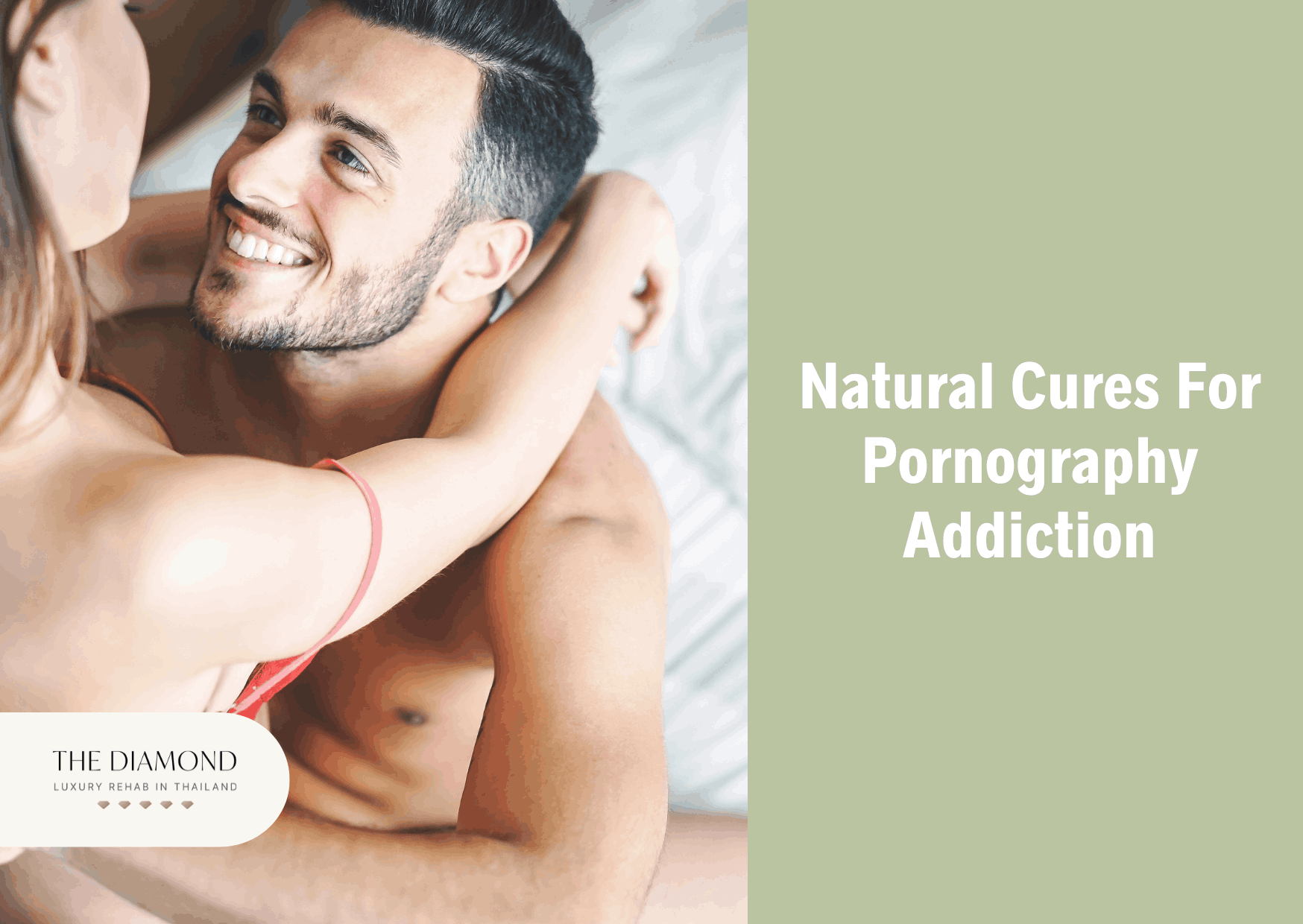Pornography addiction: signs, causes, and statistics
Table of content
- Why is porn addictive?
- What are the signs of pornography addiction?
- What are the potential causes of pornography addiction?
- What are the complications of pornography addiction?
- What are the statistics about pornography addiction?
- What are the treatments for pornography addiction?
- What other factors can influence pornography addiction?

Pornography addiction is a compulsive behavior that involves excessive viewing of pornography to a point that it affects a person’s quality of life.
Also referred to as problematic pornography viewing or compulsive pornography use, the condition remains a controversial issue in the medical community. This is because not everyone in the field is convinced that it can be considered an addiction.
The main causes of pornography addiction are brain disease, changes in brain chemistry, ease of access, and underlying mental health conditions. However, experts and advocates who believe in the existence of pornography addiction argue that there are a number of causes that lead to its development.
The most common signs and symptoms of problematic pornography viewing include an increasing amount of time spent watching porn, excessive viewing of pornography that makes one ignore other responsibilities, feelings of guilt and shame after viewing porn, and the inability to stop despite trying to do so.
The main misconceptions about pornography addiction include the opinion that porn only becomes a problem for people with addictive personalities and that only individuals with high sex drives can get addicted to porn.
Why is porn addictive?
Porn can become addictive to individuals due to the way that the brain responds to sexual images. The same brain activity shown in drug or alcohol addiction is also seen in people who compulsively use pornography. According to a 2019 systematic review published in the Journal of Clinical Medicine by Rubén de Alarcón et al. of the Institute of Biomedical Research of Salamanca in Spain, pornography is addictive because of the continuous stream of new and exciting content it provides to the brain that supposedly creates artificial stimuli. These artificial stimuli potentially activate the brain’s natural reward system at escalated levels that are novel to the brain. This process hampers the ability of the brain to differentiate between artificial stimuli and natural rewards, eventually making it more susceptible to addictive mode. Pornography from this angle resembles that of typical substance addiction.
It is worth noting that not everyone who views pornography will become addicted. The journey to pornography addiction often follows the same pattern as other addictions. For instance, a person may be exposed to pornographic images and may begin to experiment with pornography. In a 2022 narrative review published in the Journal of Addictive Diseases, Fakri Seyed Aghamiri et al. concluded that excessive pornography consumption catalyzes problematic behaviors leading to abuse and dependence which results in neglecting other activities and responsibilities. People who suffer from pornography addiction may also experience emotional distress when attempting to stop porn use.
Meanwhile, for some, problematic pornography viewing may set in due to a number of contributing factors, including genetic, environmental, and psychological factors.
What are the signs of pornography addiction?
The signs of porn addiction are indications that pornography may already be causing a problem. The most common signs of porn addiction are listed below.
- Excessive viewing of pornography: What is considered excessive may vary according to what a person feels is healthy viewing of pornography. In a case report of pornography addiction with dhat syndrome published in the Indian Journal of Psychiatry in 2014, a team led by Dr. Darshan, Founding Director & Neuropsychiatrist, Prerana Hospital for Neurocare, Psychiatry & Deaddiction, found that among the prevalent symptoms of porn addiction is spending at least 5 hours daily engaging in porn content for the past 6 years. This has led the patient to compromise social interactions, especially with family and friends, and spent hours in isolation viewing pornography. If the amount of time spent on watching porn increases and if a person engrosses in extreme types of pornography despite its harm to an individual’s personal life and relationships, these may be indicative of porn addiction.
- Reduced sexual satisfaction: Being addicted to porn can cause a loss of interest in real sex due to unrealistic sexual fantasies expressed in porn. People who suffer from pornography addiction may also experience reduced sexual satisfaction with a partner when porn is not involved. According to a 2021 study published in Frontiers in Psychology, Christina Camilleri et al. of the Franciscan University of Steubenville in Ohio emphasized that viewing pornography alone causes an adverse effect on the levels of relationship satisfaction, sexual pleasure, and intimacy in heterosexual relationships, especially when men are known pornography users.
- Engagement in risky behaviors: A person may engage in risky behaviors to view pornography, such as watching in places where it is inappropriate. These include the workplace, at school, or any other social situations where the person might be seen. It may also result in sexually-related crimes such as cyberstalking, pedophilic grooming, and online sexual harassment. A team of doctors from Lahore General Hospital in Pakistan explained in a 2023 narrative review on pornographic addiction published in Cureus that among the consequences of porn addiction is dissatisfaction with just watching and viewing pornography. This leads to performing risky sexual conduct such as an increased number of sexual partners, permissive sexual attitudes, engaging in extramarital affairs, and paying for sexual services.
- Feelings of guilt and shame: An individual who suffers from porn addiction may feel frustrated, guilty, or ashamed about the consequences of porn viewing. But despite the serious harm and feelings of guilt, these people still continue to engage in addictive behaviors around pornographic material. According to the same 2023 narrative review published in Cureus, noticeable signs of porn addiction are excessive guilt, unworthiness, and reduced self‑esteem as consequences of compulsive pornography use. The review also revealed that compulsive pornography use was linked to higher levels of anxiety, psychological stress, and depression.
- The inability to stop: One may attempt to quit using or viewing pornography but will often fail to do so. In the same 2021 study published in Frontiers in Psychology, Christina Camilleri et al. further expanded that persistent efforts to reduce or discontinue consumption of pornography are a serious indication of addiction that is also manifested in substance abuse and other behavioral types of addiction.
What are the potential causes of pornography addiction?

The potential causes of pornography addiction develop due to a complex interplay of factors which are listed below.
- Ease of access: The increased accessibility of sexually explicit material on the internet makes it easier to view endless pages of adult content with the click of a button. Moreover, the anonymity provided by the web enables compulsive behaviors to thrive in secrecy.
- Brain disease: Certain conditions such as epilepsy and dementia may cause damage to parts of the brain responsible for sexual desire. Moreover, the treatment of Parkinson’s disease with dopamine can also negatively affect the part of the brain that affects sexual behavior.
- Underlying mental health conditions: People who are struggling with other forms of addiction or other mental health conditions are more likely to use pornography as a form of escape. Certain pornography addiction recovery programs aim to manage symptoms of co-occurring mental health problems for more effective treatment.
- Biological causes: A person’s unique physiology, genetics, and brain chemistry may make someone more vulnerable to developing harmful addictions to pleasurable activities.
- Socio-cultural influences: Certain unrealistic societal and cultural views about sex may make some people turn to pornography.
What are the risk factors for pornography addiction?
The risk factors for pornography addiction include age, gender, and psychological problems. These factors may explain why pornography is addictive for certain patient populations.
The increasing exposure of children and teenagers to internet pornography contributes to the rise in porn addiction. A 2021 study by Christina Camilleri et al. published in Frontiers in Psychology, found that a significant proportion of college students have reportedly started using pornography at an earlier age. It was reported that males are initially exposed to pornography between the age of 9 and 13, whereas females, at the adolescent years of 14 and 17. Early exposure to porn is associated with increased porn viewing and addiction later in life. If left untreated, it can be traumatizing and can result in a wide array of mental health issues.
Meanwhile, studies have shown that men are more likely than women to view pornography on a daily or weekly basis. In a 2021 study published in the International Journal of Impotence Research, Dr. Fabio Zattoni et al. claimed that in modern nations, 46-74% of men and 16-41% of women are known to engage in the use of pornography. Hence, much of the research on pornography addiction has been focused on men.
Lastly, compulsive pornography use has also been associated with negative mood states or the existence of other mental health issues that may play a role in porn addiction, including anxiety disorder, depression, and poor impulse control. According to a 2019 study by Nicholas C. Borgogna et al. of the University of South Alabama published in Sexual Addiction & Compulsivity, depression was a positive indicator of problematic pornography use to escape negative thoughts and emotions.
What are the complications of pornography addiction?
The complications of pornography addiction can be physical, psychological, or social. The potential effects of not getting porn addiction help are listed below.
- Increase in sexual dysfunction
- Feelings of guilt, shame, and confusion
- Tendency to experience other addictions
- Neglecting sexual interactions with a partner
- Emotional detachment
- Relationship dissatisfaction
- Loss of focus at work
- Repeated cycles of stopping and restarting
- Mental health issues, including anxiety, depression, or suicidal ideation
What are the statistics about pornography addiction?

The statistics about pornography addiction encompass many aspects, including age, gender, and race. There is an abundance of porn addiction statistics uncovering differences in patterns of pornography viewership.
In terms of age, according to the 2018 statistics from Pornhub, the leading online adult entertainment platform, the number of pornography consumers is steadily increasing and over 70% of regular visitors to porn sites are men who are young adults or below 34 years old. Although there is increasing research and evidence of the increasing number of women using pornography in recent years, the overall prevalence of pornography consumption is still higher among men than women.
On the contrary, over 70% of adult U.S. citizens aged 18-30 years old admitted to the consumption of online pornography at least once a month. Meanwhile, almost 60% of college students admit to watching porn once a week as reported by Aleksandra Diana Dwulit and Piotr Rzyms of Poznan University of Medical Sciences in Poland in their study published in the International Journal of Environmental Research and Public Health.
Other research has also revealed racial differences in patterns of online porn consumption. In a 2017 study published in The Journal of Sex Research, researchers Samuel L. Perry and Cyrus Schleifer analyzed the effects of race, gender, and religion on pornography viewership between 1973 and 2016. The findings of the study revealed that Black Americans were more likely to consume pornography compared to Whites and the rates at which Black people increase their porn consumption is also at a higher rate than Whites. Furthermore, Black men were also more likely to view pornography than all other races or gender combinations.
What are the researches on pornography addiction?
The Diagnostic and Statistical Manual of Mental Disorders (DSM), a publication of the American Psychiatric Association, is used by healthcare professionals to help diagnose mental disorders.
The DSM does not recognize porn addiction as an official distinct diagnosis. However, a growing body of research suggests that it shares symptoms similar to what can be seen in other addictions.
For instance, a 2016 neurology review by Shane W. Kraus, Ph.D., and colleagues found that there is evidence of addiction-related brain changes in internet pornography viewers. According to the American Society of Addiction Medicine, the psychological and behavioral attributes that are indicative of an addicted human brain include cravings, impulsiveness, and weakened executive function, to name a few.
In a 2017 study published in Neuropsychopharmacology by Mateusz Gola and colleagues, the team used functional magnetic resonance imaging (fMRI) – a technique for measuring and mapping brain activity – to analyze brain responses in men for cues predicting erotic pictures. The participants were men seeking treatment for problematic pornography viewing.
The fMRI results revealed that individuals diagnosed with compulsive sexual behavior (CSB) demonstrated enhanced activation in a region of the brain called the ventral striatum. This indicates an increased desire to view erotic material. It is worth noting that the ventral striatum is also associated with drug-related cues.
The effects of porn addiction are not limited to biological aspects. In fact, one indication that pornography may already be causing a problem is that it results in damaged relationships. This is true not only for a partner but also for other friends and family members.
Samuel L. Perry, assistant professor of sociology and religious studies at the University of Oklahoma, whose research explores the changing dynamics of religious and family life in the United States, recently published a book entitled, “Addicted to Lust: Pornography in the Lives of Conservative Protestants.” The book provides an insightful study on the impact of pornography use in conservative Protestant religion and how these individuals respond to its consequences.
What are the treatments for pornography addiction?

The treatments for pornography addiction include medical, natural, and home treatments.
Medical treatments for pornography addiction involve the use of medications for people who have coexisting conditions such as depression or obsessive-compulsive disorder (OCD). In these cases, a person may use pornography to cope with the condition. Medications may help address these underlying disorders.
Meanwhile, natural treatments for pornography addiction mainly focus on making lifestyle changes. At times, problematic porn viewing results from boredom or exhaustion. A shift to a healthier lifestyle may involve spending fewer hours in front of the computer.
Home treatments for pornography addiction are another option for individuals who cannot take time off from home, school, or work. Also called outpatient therapy, this is an extensive therapy wherein the person only comes in for counseling and therapy sessions.
This way, one can still live at home, go to work, attend school, or participate in any other activities. This treatment method is also better suited for men and women who are in the early stages of the condition.
When to see a doctor or therapist for the treatment of pornography addiction
A person suffering from pornography addiction should see a doctor if they start experiencing some degree of sexual dysfunction. These are a wide range of problems that prevent a person from having satisfaction from sexual activity.
Symptoms of sexual dysfunction may include the inability to achieve orgasm, trouble achieving or maintaining an erection, and pain with intercourse. Experiencing other addictions or displaying symptoms of other mental health conditions may also be considered warning signs to get medical and professional help. In a case report of pornography addiction with dhat syndrome published in the Indian Journal of Psychiatry in 2014, a team led by Dr. Darshan, Founding Director & Neuropsychiatrist, Prerana Hospital for Neurocare, Psychiatry & Deaddiction, reported a patient case of sexual dysfunction as a consequence of pornography addiction. The patient had reported issues of arousal and erection due to the adverse effect of excessive consumption of pornography on his visual and auditory stimuli.
Psychotherapy and pharmacotherapy may also help with pornography addiction and the relationship issues associated with it. It may be time to see a therapist if the use of pornography has begun causing relationship problems, if the person has intense feelings of guilt about viewing pornographic material, or if an individual has tried to quit watching porn but has not been successful. As stated in the previously referenced case report, the patient showed significant progress a few months into receiving combined psychotherapy and pharmacotherapy treatments. It helped the patient to control his desire to watch porn, improved his self-esteem, and alleviated sexual and mental health symptoms.
The diagnostic status of porn addiction as an addictive disorder has been widely contested. But while it is not an official diagnosis in the Diagnostic and Statistical Manual of Mental Disorders-V (DSM-5), it does share some clinical conditions associated with addiction. Therefore, having these symptoms may be enough to merit a visit to the doctor or therapist. People seeking treatment should choose a like-minded therapist who shares the same beliefs and philosophy on how to cure pornography addiction.
What are the natural cures for pornography addiction?

Natural cures for pornography addiction mainly involve making significant lifestyle changes that can help to quit porn effectively. For instance, a person may try making changes to their environment. One way to do this is by avoiding triggers that may encourage someone to view pornography.
An effective approach to cure or overcome pornography addiction is restriction and intervention. An example is making changes to the settings on one’s computer or phone to make it more difficult to view explicit adult content. According to a study published by Jay A. Olson et al. in the International Journal of Mental Health and Addiction in 2022, restricting daily screen time use of computer or smartphone devices has proven effective results in reducing problematic smartphone use, which can be another means to overcome porn addiction.
Another natural cure is finding distractions. At times, some people view pornography out of boredom. In this case, joining social activities may help one get their mind off pornography. The time spent away from the computer and new bonds formed with other people is just a few benefits of social activities. In a 2023 paper published in SHS Web of Conferences, Xiangyu Wu of the Kang Chiao International School in China suggests that social media addicts can engage in more worthwhile activities as useful distractions such as reading, exercising, and spending time with family and friends, which can be similarly done to conquer porn addiction.
A person may also start exercising. Increased physical activity may help someone refocus their energy in a healthier way. According to a 2020 study published in Frontiers in Psychology by Shanshan Li et al. of Sichuan University, exercise-based intervention has effectively reduced symptoms of internet addiction. This form of intervention can also be an effective distraction for porn addiction, as exercise replaces the internet experience while also improving physical and mental health.
There is still a lot of controversy surrounding pornography addiction and whether it qualifies as a real addiction in the traditional sense. That said, research does not support a specific treatment for problematic pornography viewing.
Can rehabilitation help to treat pornography addiction?
Yes, rehabilitation can help treat pornography addiction. Rehabilitation is the process of restoring a person to health or normal life following a disabling injury, illness, or addiction. For people suffering from chronic health conditions, including cancer, diabetes, and cardiovascular diseases, rehabilitation helps minimize the disabling effects and other health risks associated with these illnesses.
The care provided in rehabilitation is also beneficial for people struggling with different kinds of addiction. Through programs that are structured with one’s recovery in mind, a person can regain independence and the ability to function normally in daily life.
As with any other addiction treatment plan, porn addiction rehabilitation should address the addiction and its underlying causes. It should also aim to identify the triggers of the behavior and change the pattern of thoughts that influence the addiction.
Pornography rehab and recovery centers offer different programs for recovery. These may include inpatient therapy, outpatient therapy, and 12-step programs.
In inpatient therapy, also known as residential treatment, patients are required to stay at an overnight facility that will provide them with full-time medical and emotional support. An inpatient program runs anywhere between 28 days and 6 months.
But for people who need to keep their job and home life intact, outpatient recovery programs may be ideal. In outpatient therapy, patients are only required to spend 10 to 12 hours a week for counseling and therapy sessions.
Meanwhile, 12-step recovery programs, such as Sex Addicts Anonymous, consist of regular meetings and support groups designed to provide people in recovery with an additional support system. These programs acknowledge a person’s powerlessness over their addiction.
What other factors can influence pornography addiction?
Other factors that contribute to pornography addiction are comorbidities and environmental factors. Comorbidity is the presence of more than one illness or disease at the same time. Having drug, alcohol, or substance use problems may make an individual more likely to suffer from sex addiction. This is also likely for people who have family members with addictive behaviors.
Early life environmental factors such as a history of physical or sexual abuse and early exposure to sexual content can also contribute to the development of porn addiction behaviors. Being in an environment where porn is frequently viewed can make an individual equate adult content with happiness. This eventually causes someone to repeatedly chase this emotion through addictive behaviors around pornographic material.

